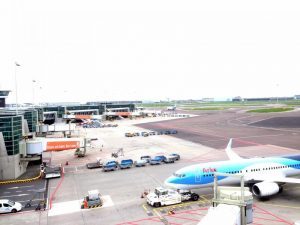 So what is the difference between non-stop, direct, and connecting flights? And why does this matter?
So what is the difference between non-stop, direct, and connecting flights? And why does this matter?
People are probably most familiar with non-stop flights, which as the name implies, takes you from point A to point B without stopping. For most people, these are the flights they try to find since they want to get to their destination in the most efficient way possible. For example, American Airlines operates non-stop flights to many cities in the Caribbean and South America from their Miami hub.
A direct flight is a flight between point A and point B, but it has one stop along the route at point C. Airlines list these flights under one flight number, and passengers may or may not have to change aircraft at the intermediate location. For example, Singapore Airlines operates a direct flight from New York JFK to Singapore Changi with a stop in Frankfurt, Germany. Both segments of this route are listed under the same flight number (in this case SQ 25 eastbound and SQ 26 westbound), and passengers do not have to change planes in Frankfurt. Another example is Delta Air Lines flight from Washington D.C. to Johannesburg, South Africa, with a stop in Atlanta (DL 200). In this case, passengers do change planes in Atlanta, but keep the same flight number for the entire journey.
Connecting flights differ from direct flights in that the segments of the journey have different flight numbers. This usually happens when you need to get from one city to another and have to pass through one of the multiple hub cities that airlines have. The 3 major airlines in the U.S. have multiple hub cities throughout the country. For example, if you travel on United from Orlando to Paris, you will most likely connect through Newark Airport, and the two segments of the trip will have separate flight numbers. Also, sometimes, but not always, a trip with connecting flights is cheaper when compared to a non-stop flight. Why? Airlines know people want to get to their destination as quickly as possible and will raise the price of a non-stop flight as a business tactic. A lower price on connecting flights will help fill smaller planes and make those flights more cost effective. It also has to do with inventory management since fares fluctuate constantly, and it pays to monitor your desired trip prior to booking it.
Why does this distinction between direct and connecting flights matter? It matters for people who are trying to earn elite status with a specific airline. To earn Silver Medallion with Delta, one of the two tasks you have to complete within a calendar year is either to fly 25,000 miles or take 30 flight segments. While this requirement can be met by flying 15 round trips in one year, it can be achieved quicker if you opt for connecting flights on a given route. For example, if you want to go from Los Angeles to Miami on Delta, you have the option of choosing a non-stop flight or a connecting flight through Atlanta. Where the non-stop option
would earn you 1 flight segment, the connecting option would earn you 2 segments. In addition, there can be more than 1 connection on a particular route. Another example is Orlando to Hanoi on Delta connects in Detroit, Seattle, and Seoul, giving you 4 flight segments on the outbound and another 4 on the inbound flight. Are there quicker ways to get between Orlando and Hanoi? Yes, but if elite status is your goal, you may opt for multiple connections in order to achieve that goal faster.
